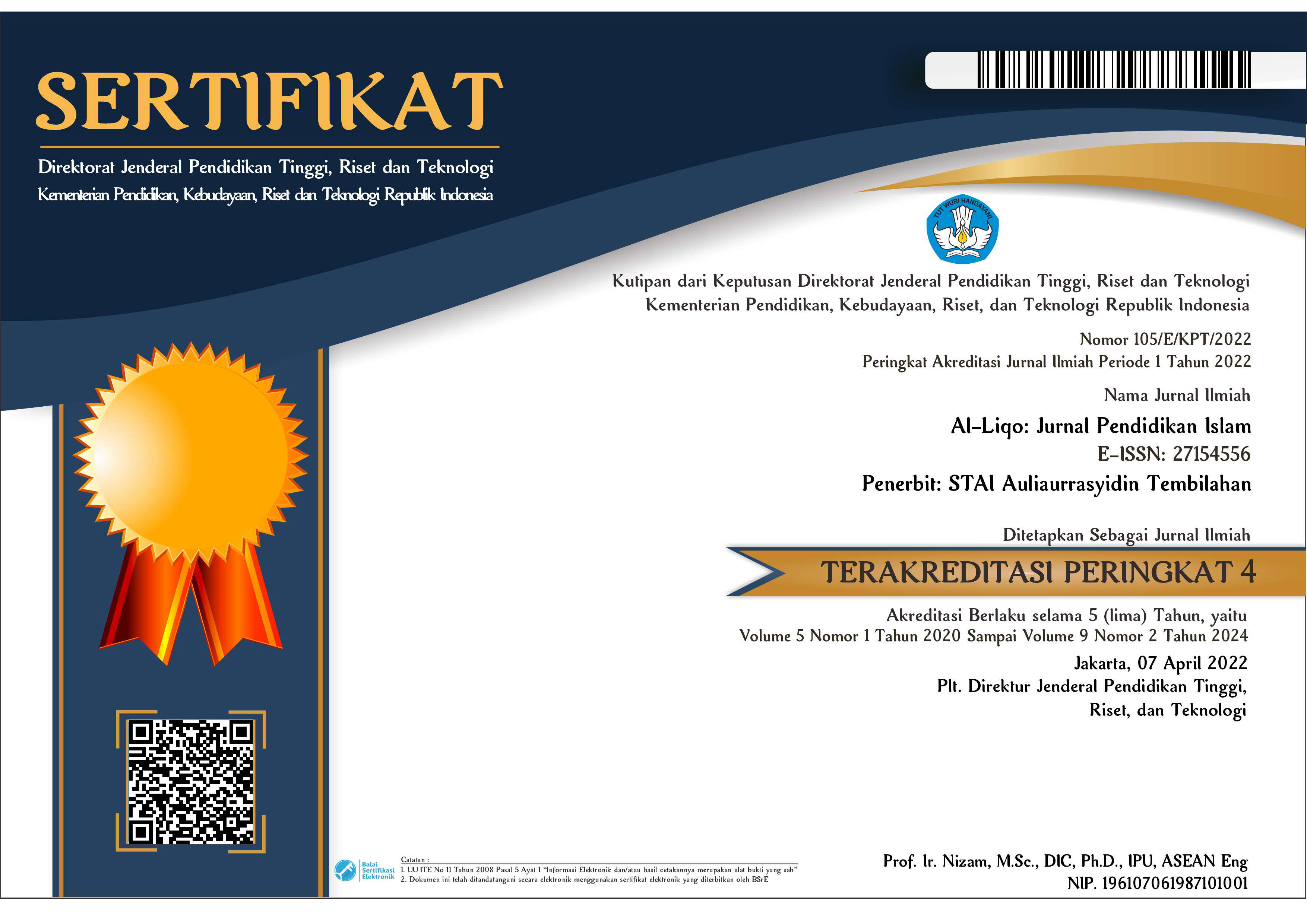Aktualisasi Nilai-Nilai Ajaran Islam Rahmatan Lil Alamin di Perguruan Tinggi Umum
DOI:
https://doi.org/10.46963/alliqo.v7i1.504Keywords:
Islamic Da'wah, The Nature of Meaning, Actualization, Rahmatan Lil' alaminAbstract
Rahmatan Lil 'alamin is a term of the Koran referring to the main purpose of da'wah carried out by the Prophet Muhammad SAW. This term is often used to explain that Islam is a religion of peace, compassion, tolerance, and love of kindness. However, in the Qur'an, the hadith and the history of the da'wah of the Prophet Muhammad and his companions show that not all activities aimed at upholding rahmatan lil' alamin can be presented with peace, compassion, tolerance, and love of kindness, but there is also the concept of jihad, amar ma' Ruf nahi munkar and wala 'with fellow believers. This paper tries to explore the meaning of grace in the Qur'an and how to make it happen with the thematic interpretation method approach. Based on the results of the study, it was found that the meaning of rahmatan lil 'alamin will be realized when there is a balance between hablun minallah and hablun minannas, namely implementing twelve activities related to the hablun minallah relationship and twelve activities related to hablun minannas.
Downloads
References
Ahmad Musthafa Al-Maraghi. (1993). Tafsir Al-Maraghi, Terj,” Bahrun Abu Bakar 30
Al-Imam Muhammad bin Aly bin Muhammad Asy Syaukany. (2003). Fathul Qodir, Diakses melalui www.altafsir.com tanggal 20 Januari 2016
Al-Imam Muhammad Fakhruddin Ibnu Al-Allamah Dliyauddin Umar. (1981). Al-Tafsir AlFakhur Razi Juz 23, Beirut: Darul Fikr.
Elly M. Setiadi. (2011). Ilmu Sosial dan Budaya, Jakarta: Kencana.
Irsyadunnas, Amar Dalam Al-Qur‟an (Kajian Tentang Ayat-ayat Taqwa)”, Jurnal Penelitian Agama, Vol. XII No.3 (September-Desember 2003).
KH. Hasyim Muzadi. (2004). Agenda Strategi Pemulihan Martabat Bangsa, Jakarta: Pustaka Azhari.
KH. Hasyim Muzadi. (2007). dengan tema, “NU, Radikalisme dan Ummatan Wasatho” dipersembahkan utunk ulangtahun Tarmizi Tahir ke-70. Hery Sucipto (ed), Islam Madzhab Tengah, Jakarta: Grafindo Khazanah Ilmu.
Khairan Muhammad Arif. (2005). Al-Ara At-Tarbawiyah indal Imam Ibnu Qayim Al-Jauziyah, Kairo: Liga Arab.
Makmun Rasyid, Muhammad. (2016). Islam Rahmatan lil ‘Alamin Perspektif KH. Hasyim muzadi, Jurnal Epistemé, Vol. 11, No. 1.
Moh.Arif, Membangun Kepribadian Muslim melalui Taqwa dan Jihad, Jurnal Studi Agama, Vol. 7 No. 2 (Desember 2013), 344.
Muvid, Muhamad Basyrul. (2021). Menjunjung Tinggi Islam Agama Kasih Sayang Dan Cinta Kasih Dalam Dimensi Sufisme. Reflektika 16.2
Nurcholish Madjid. (1992). Islam Doktrin Dan Peradaban. CP. Yayasan Wakaf Paramadina, Jakarta.
Nurtanio Agus Purwanto. (2007). Pendidikan dan Kehidupan Sosial, Jurnal Managemen Pendidikan, No.02.Th III.
Downloads
Published
Issue
Section
License
Authors who publish with this journal agree to the following terms:
1. Copyright on any article is retained by the author(s).
2. The author grants the journal, right of first publication with the work simultaneously licensed under a Creative Commons Attribution shareAlike 4.0 International License that allows others to share the work with an acknowledgment of the work’s authorship and initial publication in this journal.
3. Authors are able to enter into separate, additional contractual arrangements for the non-exclusive distribution of the journal’s published version of the work (e.g., post it to an institutional repository or publish it in a book), with an acknowledgment of its initial publication in this journal.
4. Authors are permitted and encouraged to post their work online (e.g., in institutional repositories or on their website) prior to and during the submission process, as it can lead to productive exchanges, as well as earlier and greater citation of published work.
5. The article and any associated published material is distributed under the Creative Commons Attribution-ShareAlike 4.0 International License







2.png)



